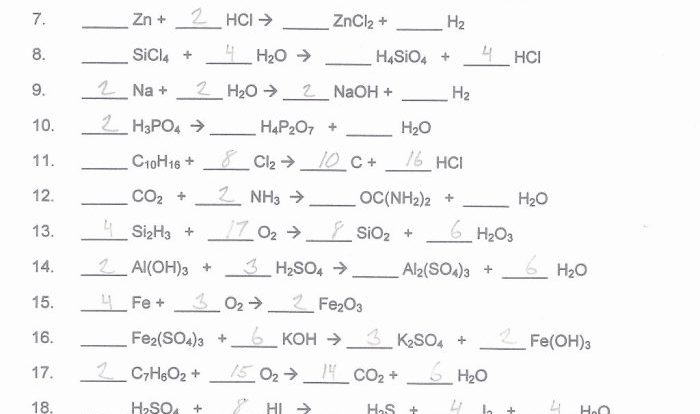Embark on an enlightening journey into the realm of chemical reactions with the Gizmo Limiting Reactants answer key. This comprehensive guide unlocks the secrets of limiting reactants, empowering you to unravel the mysteries of chemical interactions. Delve into the intricacies of stoichiometry and witness the pivotal role it plays in determining the limiting reactant, a crucial factor that governs the course of a reaction.
Prepare to be captivated as we explore the Gizmo Limiting Reactants simulation, an interactive tool that brings the concepts to life. Witness firsthand how limiting reactants influence industrial processes and everyday life, unraveling their practical applications in a thought-provoking manner.
Gizmo Limiting Reactants: Gizmo Limiting Reactants Answer Key
In a chemical reaction, the limiting reactant is the reactant that is completely consumed, thereby limiting the amount of product that can be formed. The other reactants are said to be in excess.
For example, consider the reaction between hydrogen and oxygen to form water:
“`
H2 + O2 → 2H2O
“`
If we start with 4 moles of hydrogen and 2 moles of oxygen, the hydrogen will be the limiting reactant because it will be completely consumed before all of the oxygen is used up. This is because the mole ratio of hydrogen to oxygen in the balanced equation is 2:1, meaning that 2 moles of hydrogen are required for every 1 mole of oxygen.
Since we have 4 moles of hydrogen and only 2 moles of oxygen, the hydrogen will be used up first.
Determining the limiting reactant is important because it allows us to predict the maximum amount of product that can be formed in a reaction. In the example above, we know that the maximum amount of water that can be formed is 2 moles, because this is the amount that can be formed from the limiting reactant (hydrogen).
Limiting Reactants and Stoichiometry
Stoichiometry is the branch of chemistry that involves the study of the quantitative relationships between reactants and products in chemical reactions. It plays a crucial role in determining the limiting reactant in a reaction.
The limiting reactant is the reactant that is completely consumed in a reaction, thereby limiting the amount of product that can be formed. To determine the limiting reactant using stoichiometry, follow these steps:
Step-by-Step Guide to Calculating Limiting Reactant
- Balance the chemical equation:Ensure that the number of atoms of each element is the same on both sides of the equation.
- Convert the given amounts of reactants to moles:Use the molar mass of each reactant to convert the given mass or volume to moles.
- Compare the mole ratios:Divide the number of moles of each reactant by its stoichiometric coefficient in the balanced equation. The reactant with the smallest mole ratio is the limiting reactant.
- Calculate the theoretical yield:Use the stoichiometry of the balanced equation to calculate the maximum amount of product that can be formed from the limiting reactant.
Example: Determining Limiting Reactant
Consider the following reaction:
“`
H2+ O 2→ 2 H 2O
“`
If 4 moles of H 2and 3 moles of O 2are reacted, determine the limiting reactant.
Solution:
- Convert to moles:4 moles H 2and 3 moles O 2
- Compare mole ratios:
- H 2: 4 moles / 2 = 2
- O 2: 3 moles / 1 = 3
- Limiting reactant:H 2(smaller mole ratio)
Therefore, H 2is the limiting reactant, and it will determine the maximum amount of H 2O that can be produced.
Gizmo Limiting Reactants Simulation
The Gizmo Limiting Reactants simulation is an interactive tool that allows students to investigate limiting reactants. The simulation presents a chemical reaction and provides students with the ability to adjust the initial amounts of reactants. Students can then observe the reaction and determine which reactant is limiting.The
simulation can be used to investigate a variety of limiting reactant scenarios. For example, students can explore the effects of changing the initial amounts of reactants, the stoichiometry of the reaction, and the presence of a catalyst. The simulation can also be used to demonstrate the concept of the limiting reactant and how it affects the products of a reaction.
How to Use the Simulation to Determine the Limiting Reactant, Gizmo limiting reactants answer key
To use the simulation to determine the limiting reactant, students should follow these steps:1.
-
-*Open the simulation. The simulation can be found at the following link
https://www.explorelearning.com/simulations/Exponential-Growth-and-Decay/
- 2.
- *Select a reaction. The simulation includes a variety of pre-defined reactions. Students can also create their own reactions by entering the stoichiometry of the reaction into the “Reaction” field.
- 3.
- *Adjust the initial amounts of reactants. Students can adjust the initial amounts of reactants by dragging the sliders or entering the values into the “Initial Amounts” fields.
- 4.
- *Run the simulation. Students can run the simulation by clicking the “Run” button.
- 5.
- *Observe the reaction. The simulation will show the progress of the reaction. Students should observe the reaction until it reaches completion.
- 6.
- *Determine the limiting reactant. The limiting reactant is the reactant that is completely consumed in the reaction. Students can determine the limiting reactant by looking at the “Final Amounts” table. The limiting reactant will have a final amount of zero.
Applications of Limiting Reactants
Understanding limiting reactants has numerous practical applications in various fields, including industrial processes and everyday life.
Industrial Processes
In industrial settings, limiting reactants play a crucial role in optimizing chemical reactions for efficient production.
- By identifying the limiting reactant, industries can determine the precise amount of each reactant required, minimizing waste and maximizing product yield.
- In the Haber process for ammonia production, for instance, understanding the limiting reactant (nitrogen) ensures optimal nitrogen utilization, reducing energy consumption and increasing ammonia yield.
Everyday Life
Limiting reactants also find applications in everyday life, influencing the outcome of various reactions:
- In baking, the limiting reactant (often baking soda or powder) determines the amount of gas produced, affecting the rise and texture of baked goods.
- In combustion reactions, such as burning fuel in a car engine, the limiting reactant (usually oxygen) controls the completeness of combustion, influencing fuel efficiency and emissions.
Top FAQs
What is the significance of identifying the limiting reactant?
Determining the limiting reactant is crucial because it dictates the maximum amount of product that can be formed in a chemical reaction. It helps predict the reaction’s yield and provides valuable insights into the reaction’s efficiency.
How does the Gizmo Limiting Reactants simulation aid in understanding limiting reactants?
The Gizmo Limiting Reactants simulation provides an interactive platform to visualize and experiment with limiting reactants. It allows users to manipulate reactant quantities, observe reaction progress, and analyze the impact of limiting reactants on product formation.
What are some practical applications of understanding limiting reactants?
Understanding limiting reactants has wide-ranging applications in various fields, including industrial chemistry, pharmaceuticals, and environmental science. It helps optimize chemical processes, predict reaction outcomes, and design experiments effectively.

